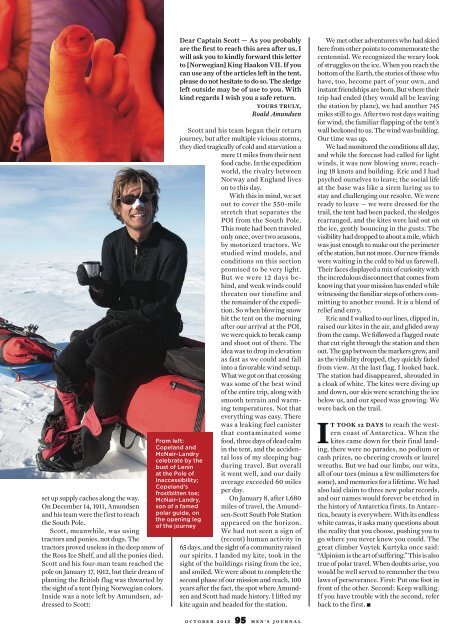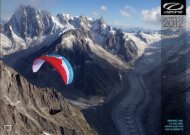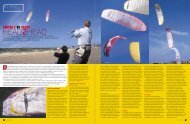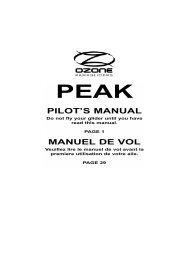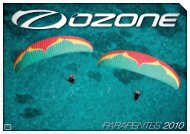81 DAYS ON THE ICE - Ozone
81 DAYS ON THE ICE - Ozone
81 DAYS ON THE ICE - Ozone
You also want an ePaper? Increase the reach of your titles
YUMPU automatically turns print PDFs into web optimized ePapers that Google loves.
set up supply caches along the way.<br />
On December 14, 1911, Amundsen<br />
and his team were the first to reach<br />
the South Pole.<br />
Scott, meanwhile, was using<br />
tractors and ponies, not dogs. The<br />
tractors proved useless in the deep snow of<br />
the Ross Ice Shelf, and all the ponies died.<br />
Scott and his four-man team reached the<br />
pole on January 17, 1912, but their dream of<br />
planting the British flag was thwarted by<br />
the sight of a tent flying Norwegian colors.<br />
Inside was a note left by Amundsen, addressed<br />
to Scott:<br />
Dear Captain Scott — As you probably<br />
are the first to reach this area after us, I<br />
will ask you to kindly forward this letter<br />
to [Norwegian] King Haakon VII. If you<br />
can use any of the articles left in the tent,<br />
please do not hesitate to do so. The sledge<br />
left outside may be of use to you. With<br />
kind regards I wish you a safe return.<br />
yours truly,<br />
Roald Amundsen<br />
Scott and his team began their return<br />
journey, but after multiple vicious storms,<br />
they died tragically of cold and starvation a<br />
mere 11 miles from their next<br />
food cache. In the expedition<br />
world, the rivalry between<br />
Norway and England lives<br />
on to this day.<br />
With this in mind, we set<br />
out to cover the 550-mile<br />
stretch that separates the<br />
POI from the South Pole.<br />
This route had been traveled<br />
only once, over two seasons,<br />
by motorized tractors. We<br />
studied wind models, and<br />
conditions on this section<br />
promised to be very light.<br />
But we were 12 days behind,<br />
and weak winds could<br />
threaten our timeline and<br />
the remainder of the expedition.<br />
So when blowing snow<br />
hit the tent on the morning<br />
after our arrival at the POI,<br />
we were quick to break camp<br />
and shoot out of there. The<br />
idea was to drop in elevation<br />
as fast as we could and fall<br />
into a favorable wind setup.<br />
What we got on that crossing<br />
was some of the best wind<br />
of the entire trip, along with<br />
smooth terrain and warming<br />
temperatures. Not that<br />
everything was easy. There<br />
was a leaking fuel canister<br />
that contaminated some<br />
food, three days of dead calm<br />
in the tent, and the accidental<br />
loss of my sleeping bag<br />
during travel. But overall<br />
it went well, and our daily<br />
average exceeded 60 miles<br />
per day.<br />
On January 8, after 1,680<br />
miles of travel, the Amundsen-Scott<br />
South Pole Station<br />
appeared on the horizon.<br />
We had not seen a sign of<br />
( recent) human activity in<br />
65 days, and the sight of a community raised<br />
our spirits. I landed my kite, took in the<br />
sight of the buildings rising from the ice,<br />
and smiled. We were about to complete the<br />
second phase of our mission and reach, 100<br />
years after the fact, the spot where Amundsen<br />
and Scott had made history. I lifted my<br />
kite again and headed for the station.<br />
From left:<br />
Copeland and<br />
McNair-Landry<br />
celebrate by the<br />
bust of Lenin<br />
at the Pole of<br />
Inaccessibility;<br />
Copeland’s<br />
frostbitten toe;<br />
McNair-Landry,<br />
son of a famed<br />
polar guide, on<br />
the opening leg<br />
of the journey<br />
We met other adventurers who had skied<br />
here from other points to commemorate the<br />
centennial. We recognized the weary look<br />
of struggles on the ice. When you reach the<br />
bottom of the Earth, the stories of those who<br />
have, too, become part of your own, and<br />
instant friendships are born. But where their<br />
trip had ended (they would all be leaving<br />
the station by plane), we had another 745<br />
miles still to go. After two rest days waiting<br />
for wind, the familiar flapping of the tent’s<br />
wall beckoned to us. The wind was building.<br />
Our time was up.<br />
We had monitored the conditions all day,<br />
and while the forecast had called for light<br />
winds, it was now blowing snow, reaching<br />
18 knots and building. Eric and I had<br />
psyched ourselves to leave; the social life<br />
at the base was like a siren luring us to<br />
stay and challenging our resolve. We were<br />
ready to leave — we were dressed for the<br />
trail, the tent had been packed, the sledges<br />
rearranged, and the kites were laid out on<br />
the ice, gently bouncing in the gusts. The<br />
visibility had dropped to about a mile, which<br />
was just enough to make out the perimeter<br />
of the station, but not more. Our new friends<br />
were waiting in the cold to bid us farewell.<br />
Their faces displayed a mix of curiosity with<br />
the incredulous disconnect that comes from<br />
knowing that your mission has ended while<br />
witnessing the familiar steps of others committing<br />
to another round. It is a blend of<br />
relief and envy.<br />
Eric and I walked to our lines, clipped in,<br />
raised our kites in the air, and glided away<br />
from the camp. We followed a flagged route<br />
that cut right through the station and then<br />
out. The gap between the markers grew, and<br />
as the visibility dropped, they quickly faded<br />
from view. At the last f lag, I looked back.<br />
The station had disappeared, shrouded in<br />
a cloak of white. The kites were diving up<br />
and down, our skis were scratching the ice<br />
below us, and our speed was growing. We<br />
were back on the trail.<br />
IT TOOK 12 <strong>DAYS</strong> to reach the western<br />
coast of Antarctica. When the<br />
kites came down for their final landing,<br />
there were no parades, no podium or<br />
cash prizes, no cheering crowds or laurel<br />
wreaths. But we had our limbs, our wits,<br />
all of our toes (minus a few millimeters for<br />
some), and memories for a lifetime. We had<br />
also laid claim to three new polar records,<br />
and our names would forever be etched in<br />
the history of Antarctica firsts. In Antarctica,<br />
beauty is everywhere. With its endless<br />
white canvas, it asks many questions about<br />
the reality that you choose, pushing you to<br />
go where you never knew you could. The<br />
great climber Voytek Kurtyka once said:<br />
“Alpinism is the art of suffering.” This is also<br />
true of polar travel. When doubts arise, you<br />
would be well served to remember the two<br />
laws of perseverance. First: Put one foot in<br />
front of the other. Second: Keep walking.<br />
If you have trouble with the second, refer<br />
back to the first. <br />
OCTOBER 2012 95<br />
MEN’S JOURNAL


